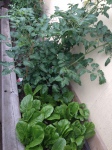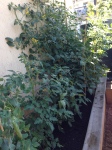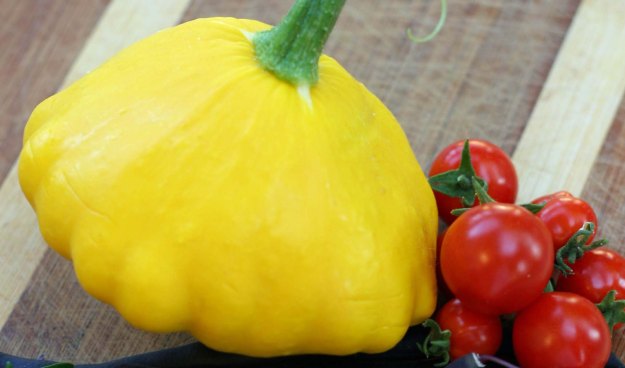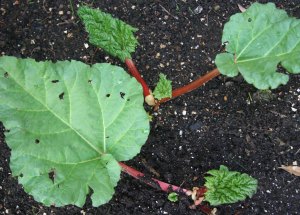Well! Here we are in July already! I figured now was a good time for a review of all that’s gone on in the garden so far this season – complete with “progress to date” photo gallery.
It seems so early to even be eating from my garden yet, as last year the abundance all happened in late August, but really, that’s only 6 weeks away and there’s lots of growing still to do. And while I’m still experimenting, I did do some more timing-type planning this year to try for a longer “eating” season, and so far, it’s (mostly) working.
I started planting on April 12th to be exact, a bit late really in most peoples’ books, but I like a later harvest in the hot days of late summer. Just spinach and some lettuce to start, peas and potatoes a week later, with kale and more lettuce the week after that. I only know this because, for the first time ever, I scribbled in my calendar with a sharpie whenever I planted this year. Whatever works!
In the gallery below, the “early on” photos were from about mid-May, around my second favourite stage of the season – the seedlings are such an adorable little burst of victory!
And you can likely guess what my favourite stage is, right? Eating!
- Very early! Peas
- Early on – Lettuce and tomato
- Early on – Potatoes
- Early on – Peas and tomato
- Early on – Beans
- 6 weeks in – Kale and squashes
- 6 weeks in – Lettuce and tomato
- 6 weeks in – Potatoes
- 8 weeks in – tomatoes
- May Spinach
- June Peas
- June lettuce, kale, peas and mint
- June mint
- Freezing extra kale
- Our first apples!
We got to harvest the spinach first – it came so quickly, but low and behold, it was so hot in May that we only got through 2/3 of it before it bolted! We do get hot spells in May now and again, and then “June-uary” is usually rainy and colder. So next year, I’ll start the spinach earlier, really I will! In fact, I’ll start it again soon, so I can have spinach for my smoothies in fall and winter!
Next came the lettuce, and then the kale. I planted a fair bit, as we eat lettuce and kale almost every day in our salads and smoothies. I thinned a few out, and the rest I’ve just been harvesting the outer leaves, and as promised but always to my surprise, they are growing back!
I got a LITTLE more kale than I could handle, so I just steamed it up, pureed it with the hand blender, froze it in ice cube trays and put in a Ziploc bag in the freezer for later. This time, I actually measured and surprisingly, a whole cup of fresh spinach makes about 1 cube frozen! Just pop one cube in your blender and you’ll have the right amount of greens for your next green smoothie. I have LOTS of great things to say about Simple Green Smoothies, but it’s too much for this post, so I’ll just link to them here and leave it for another day!
The herbs have started to come, and my favourites are the ones I can put in cocktails, like mint for mojitos!
I don’t usually plant peas, and may not again, but my sister gave me some seeds from last year, so how could I turn her down?! They take up a lot of space for a small harvest, but they are so sweet, and the kids love shelling and eating them straight from the garden, so I sacrificed some space this year for this lovely treat. The peas are almost done now, so I’m hoping to plant something else there in its place in a week or two.
I’d be remiss if I didn’t talk about what HASN’T gone well in the garden so far. Humph.
I tried a bag of mushroom manure in one of the front boxes this year, and guess what mostly grew there? Right……mushrooms. Almost exclusively. Arggghh. So I re-fertilized, threw in some animal manure and replanted chard, spinach and a row of carrots around mid June. It might have been too late, and the soil may have been suspect, but my fingers are crossed. Not all of the seeds have come up, so something is definitely a little off in that box.
My cukes, squash and carrots have been in the ground for 5 weeks already, near each other, and they seem very small to me. Hmmm. I left lots of room for the patty pan squash, but I think I gapped out and planted the cukes and zukes way too close together.
Solution: get out a few pots and transplant them elsewhere so the strong seedlings don’t go to waste!
The beans are doing fine, and are mostly ornamental anyway, as I just grow them in pots or let them climb the fence and don’t allow too much space for them, and I’ve never grown potatoes before, but aside from the odd yellow leaf, I’m still hopeful they will produce!
And lastly, it’s the glorious tomatoes that I’m really holding out for, and like the rest of my garden, I planted them in succession so I could enjoy them longer. One in May, two in June. And to my delight, exactly 60 days since she went in the ground, I glimpsed the first ripe little gem this morning.
Time has gone so fast, I can’t believe it’s 12-1/2 weeks into the season already. I do wish a few things were further along, but I’m trying to let go and just trust they will provide.
What’s happening in your garden today?





















